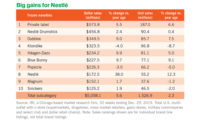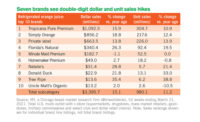
Good Times
Another year has
passed — another 12 months of new product introductions, another 365
days, each with — the industry hopes — at least three servings
of dairy consumed by members of households across the nation.
The past year has brought a series of marketing
campaigns designed to leverage medical research showing dairy’s
important role in maintaining a healthy weight. But despite these efforts,
market forces appear to be hindering their progress.
While milk prices reach record highs, market research
data shows dollar sales rising but unit sales decreasing across all fluid
categories— even flavored, considered the growth engine for improving
milk’s standing as a beverage of choice among carbonated, sugar-laden
options.
Not that the past year hasn’t offered
consumers a choice. On the contrary, there has never been more of a choice
of products, especially with the low-carbohydrate craze driving the latest
better-for-you growth spurt.
Of the 3-A-Day components — milk, yogurt and
cheese — two offer low-carb options, while the third is naturally low
in carbohydrates. All three also offer lowfat and fat-free varieties,
covering all dairy-eating lifestyles.
Now, reports are beginning to surface indicating the
bloom may be off the low-carb rose. Data reported by USA Today shows that while sales
of foods labeled as low carb increased more than 280 percent between July
2003 and last month, sales for the 13-week period at the end of that year
were up just 20 percent, after increasing 122 percent in the previous 13
weeks. Could this be signaling the eventual abandonment of much-ballyhooed
low-carb alternative products for the good old standards?
Turning to industry matters, the outlook seems
bright for processors. A bill to make forward contracting permanent is
advancing through Congress. President Bush signed changes to federal
nutrition policy giving milk a more prominent spot in schools. And farm
milk prices have started to fall from their historic highs, offering hope
that retail prices might start to drop enough to help shore up plummeting
sales. The USDA reported July retail prices for whole and reduced-fat milk
were down after spikes in May and June.
Meanwhile, the latest WTO ag talks herald greater
opportunities for the U.S. dairy industry on the world stage, as global
demand for dairy products continues to grow.
The industry itself continues to get a little
smaller. Since Dairy Field published its Top 100 processor ranking in June, No. 6
Schreiber Foods acquired No. 69 Level Valley Creamery, the Green Bay,
Wis.-based private label manufacturer’s latest step in growing even
larger. Dreyer’s Grand Ice Cream, after merging with
Nestlé’s ice cream interests, took over Silhouette, makers of
Skinny Cow frozen desserts. And DFA is picking up some of the pieces as
Parmalat’s meltdown hits U.S. shores.
But then, DFA could conceivably end up a little
smaller as well, depending on the eventual outcome of an antitrust probe of
the cooperative launched by the Department of Justice. Federal prosecutors
have heard testimony from several Louisiana dairy farmers in connection
with allegations that DFA is trying to corner certain regional raw-milk
markets.
The investigation will determine whether DFA is
flexing its monopolistic muscle or whether it’s all just another page
in the ongoing saga of industry-wide consolidation.
True, major processors are getting larger and growing
in influence, but it doesn’t seem to be having a negative impact on
new product choices offered to consumers. While smaller companies might
lack the layers of corporate bureaucracy through which new ideas must
burrow, larger companies have pockets deep enough to enrich their R&D
endeavors.
But you can judge for yourself how well the industry
is serving its consumers. This month, our State of the Industry report
breaks it down, looking at how far things have come in the past year
and where they’re going next.
To borrow a phrase from one of our section sponsors, it seems
to be a great time to be in dairy. df
$OMN_arttitle="Good Times";?>

